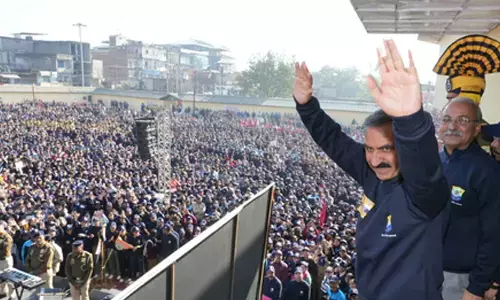Clean the air

The most crucial inclusion in the India-US Joint statement issued on September 30 is the strategic partnership on energy and climate change.
The most crucial inclusion in the India-US Joint statement issued on September 30 is the strategic partnership on energy and climate change. The actions agreed will have far-reaching impact on India's poor, neo-middle class and youth. They will also enhance the image of an India as a steward in international negotiations on environment.
At WTO, India resisted the American pressure to amend Trade Facilitation Agreement (TFA), only to protect the hundreds of millions of poor and hungry Indians. Now, India, through actions planned in partnership with the US, has unique opportunity to act on climate change and secure future of poor workers and farmers.
Till now India, over the last 17 years has been resisting at international meetings to avail an important the opportunity to make its refrigeration and air conditioning industry move away from a refrigerant – hydro chloro flurocarbons (HFCs). Nearly 100 countries including the US and Japan and those in Europe have given their consent, but India continues to block this agreement. Many countries are even advancing to implement it. In Europe, for example, a new law will phase down HFCs by 80 per cent by 2030. In the US, President Barack Obama is also using his regulatory authority to shift away from HFCs – and is promising to do even more.
India's blockade, unlike in case of WTO, is not for the interest of the poor. Far from it. Indian negotiators question the availability of alternatives to HFCs. They debate if the Montreal Protocol is the right forum for the action against HFCs. In reality, this stand completely ignores the opportunity for India to avail of larger national benefits for the poor and neo-middle class.
The refrigeration and air-conditioning industry has made enormous contribution to protect the stratospheric ozone layer by effectively implementing the Montreal Protocol. By 2010, as per the Montreal Protocol, it had eliminated production and consumption of CFCs. Now it, like other developing countries, is phasing out the last remaining ozone-depleting chemical - HFCs.
As the plans declared by Prime Minister Narendra Modi for 100 smart cities goes on stream, as the cold storage requirements increase to feed in those cities, as the number of refrigerated facilities increase to prevent the waste of perishables to give better income to farmers for their produce, the demand for HFCs would further rise. If left unchecked, by 2050, annual HFC emissions could be equivalent to 12 percent of annual CO2 emissions under a business-as-usual scenario and up to 75 percent of annual CO2 emissions under the IPCC's strongest mitigation scenario.
Scientific studies say global fast action on HFCs phase down will avoid up to 200 billion tonnes of CO2 emissions by 2050 and up to 0.5 degrees Celsius of warming by 2100. Avoiding this warming is essential for staying within the long-term international goal of stabilizing global temperature rise at or below 2 degrees Celsius over pre-industrial temperatures by the end of the century. Are the alternatives to HFCs available? Godrej in India has already commercialized room air-conditioners without HFCs. It uses hydrocarbons (HC), which are easily available in India and much cheaper. When India phased out CFCs, the energy efficiency of the appliances using CFC-alternatives went up to the extent of nearly 30 percent to 60 percent. A recent study by the Lawrence Berkeley National Laboratory of US calculates that super-efficient air conditioning in India could avoid the need to build up to 120 medium-sized power plants by 2030. This would save $60 billion just in construction costs.
Implementing HFC phase-down under the Montreal Protocol, India during negotiations can insist on applying the same rules as accepted under the Montreal Protocol - getting a grace period by requesting industrialized countries to carry out HFC phase-down first, ensuring that alternatives are available and affordable. This opportunity is being withered away by India for last few years.
The Clean India campaign pronounced by Modi should not be restricted only to sweeping the roads, brushing the walls and dusting the files. It should move beyond - and also clean the skies from air pollution by making ACs super-efficient and HFC free.
















